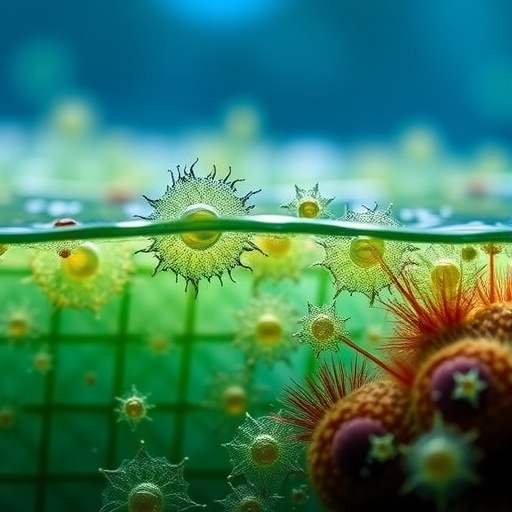In the vast and nutrient-poor expanses of the world’s oceans, microscopic alliances between algae and bacteria orchestrate vital biochemical processes that sustain marine ecosystems. A groundbreaking study led by researchers at Stockholm University, in collaboration with the Swedish University of Agricultural Sciences and Linnaeus University, delves deeply into one such remarkable partnership. Published in the upcoming issue of Current Biology, this work unveils how cyanobacterial symbionts gradually lose genes and evolve towards increasing dependence on their diatom hosts, offering unprecedented insights into symbiotic genome evolution.
Diatoms, unicellular algae recognized for their intricate silica shells, engage in a fascinating relationship with cyanobacteria of the genus Richelia. These bacteria have the extraordinary ability to fix atmospheric nitrogen (N₂), converting inert nitrogen gas into biologically usable forms that nourish their photosynthetic hosts. This nitrogen fixation is crucial in oligotrophic waters where essential nutrients are scarce, thus sustaining productivity within these harsh marine environments.
The symbiotic association between Richelia cyanobacteria and their diatom hosts exists along a continuum of integration. Some Richelia species reside externally, adhering to the diatom cell wall, while others occupy spaces between the diatom’s frustule—the characteristic silica shell—and the inner cellular membranes. The most intimate interactions occur when Richelia live completely inside the host cell. This gradient of physical association uniquely captures distinct evolutionary stages of symbiont integration, allowing researchers to analyze genome reduction and functional adaptation across the symbiotic spectrum.
Professor Rachel Foster, a co-author from Stockholm University, highlights that as these cyanobacteria become increasingly reliant on their hosts, they undergo a process of genome streamlining. Redundant genes, whose functions overlap with those of the host, tend to be lost over time. This gene loss is accompanied by an increase in genetic integration and interdependence, reflecting the transition from a facultative symbiont to a fully endosymbiotic lifestyle.
The team applied comprehensive comparative genomics to investigate these transformations. Led by postdoctoral researcher Dr. Vesna Grujcic, the analysis mapped gene content changes across different Richelia strains. This pangenomic approach distinguished the “core genome”—genes conserved across all strains—from accessory genes that vary. The study revealed clear patterns: genes involved in independent survival and certain metabolic pathways diminish as the symbiont becomes more embedded within the host. This genomic paring down provides a rare stepwise glimpse into the evolutionary finesse by which a free-living bacterium transitions into a host-dependent organelle-like entity.
Beyond mere gene loss, the study examined the landscapes between genes known as intergenic spacers, and the proliferation of pseudogenes—formerly functional genes that have accumulated debilitating mutations. Maliheh Mehrshad, collaborating in the study, emphasized that not only does the genome shrink in size, but the quality of coding sequences evolves. Non-coding DNA regions and the prevalence of pseudogenes serve as molecular signposts, chronicling the pace and trajectory of genome reduction driven by symbiotic commitments.
An additional layer of complexity was unveiled regarding the role of mobile genetic elements, often referred to as “jumping genes.” Theo Vigil-Stenman, formerly a postdoctoral researcher at Stockholm University, meticulously characterized insertion sequences and transposons—a type of DNA element that can relocate within the genome. These sequences were found to inflate the genome size of certain partially integrated symbionts, particularly those nestled between the diatom’s outer shell and inner membrane, despite functionally streamlined metabolic pathways.
This genomic inflation by mobile elements counters the simplistic assumption that genome size always correlates with symbiont integration level. The presence of abundant insertion sequences suggests that transposable elements actively shape symbiont genomic architecture, possibly influencing gene loss patterns and symbiotic evolution. Understanding these dynamics reveals the nuanced and multifaceted genomic remodeling symbionts undergo during their gradual encroachment into host cellular territory.
The research team advocates for the diatom-Richelia partnerships as a powerful model system to study symbiont genome evolution in real time. Unlike many obligate symbioses locked into highly derived states, these associations exist simultaneously across a spectrum of integration stages. This natural laboratory permits exploration of fundamental questions about the origins of endosymbiosis, genome reduction mechanisms, and the genetic underpinnings of host dependency.
While this study has illuminated critical aspects of the symbiont journey towards endosymbiosis, numerous mysteries remain. For example, the evolutionary consequences of living in symbiosis on the diatom host genomes themselves are yet to be fully unraveled. Additionally, investigators wonder how insights gleaned from these natural nitrogen-fixing partnerships can inform synthetic biology efforts to engineer nitrogen-fixing capabilities in crops—potentially revolutionizing sustainable agriculture by reducing dependency on chemical fertilizers.
The ability of Richelia to convert atmospheric nitrogen into a bioavailable form for their hosts is a compelling example of microbial cooperation with ecological and biotechnological significance. By dissecting the stepwise genome evolution that accompanies this symbiotic lifestyle, the research sets the stage for harnessing symbiont genetics to meet global challenges such as food security and environmental sustainability.
The article detailing these findings, titled “Stepwise genome evolution from a facultative symbiont to an endosymbiont in the N₂-fixing diatom-Richelia symbioses,” is accessible in Current Biology. This landmark work exemplifies how cutting-edge genomics paired with symbiosis biology can unravel complex evolutionary narratives, tracing microbial partnerships that have shaped life in the oceans for millions of years.
Subject of Research: Cells
Article Title: Stepwise genome evolution from a facultative symbiont to an endosymbiont in the N₂-fixing diatom-Richelia symbioses
News Publication Date: 29-Aug-2025
Web References:
https://www.cell.com/current-biology/fulltext/S0960-9822(25)01034-6
References:
DOI: 10.1016/j.cub.2025.08.003
Image Credits:
Images by Dr. Vesna Grujcic.
Keywords:
Symbiosis, Epifluorescence microscopy, Microbial genetics, Microorganisms, Algae, Diatoms, Bacteria, Cyanobacteria, Nitrogen fixation, Nitrogen fixing bacteria, Mobile genetic elements




